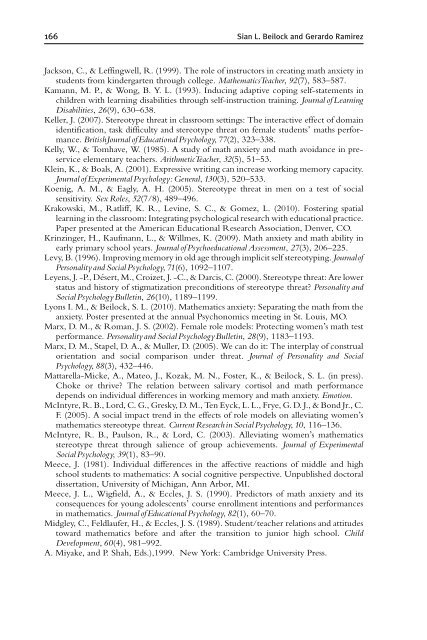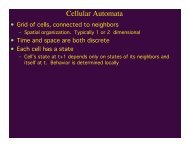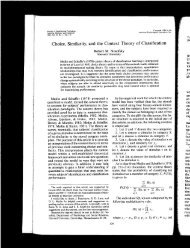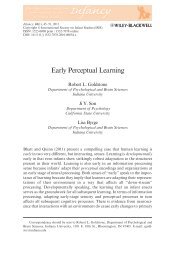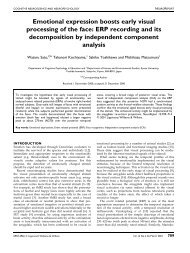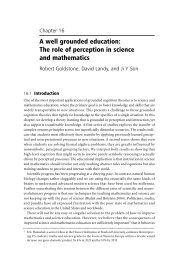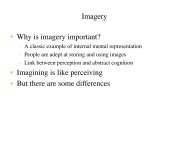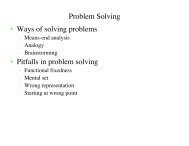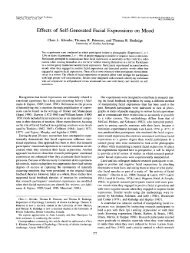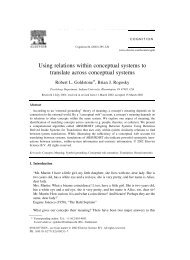Implications for Enhancing Academic Achievement 165Faust, M. W., Ashcraft, M. H., & Fleck, D. E. (1996). Ma<strong>the</strong>matics anxiety effects insimple <strong>and</strong> complex addition. Ma<strong>the</strong>maticalCognition, 2(1), 25–62.Fennema, E. (1989). The study <strong>of</strong> affect <strong>and</strong> ma<strong>the</strong>matics: A proposed generic model forresearch. In D. B. McLeod, <strong>and</strong> V. M. Adams, Eds.), A¡ect <strong>and</strong> ma<strong>the</strong>matical problemsolving: Anewperspective (pp. 205–219). New York: Springer-Verlag.Fennema, E., Peterson, P. L., Carpenter, T. P., & Lubinski, C. A. (1990). Teachers’attributions <strong>and</strong> beliefs about girls, boys, <strong>and</strong> ma<strong>the</strong>matics. Educational Studies inMa<strong>the</strong>matics, 21(1), 55–69.Fiore, G. (1999). Math-abused students: Are we prepared to teach <strong>the</strong>m? Ma<strong>the</strong>maticsTeacher, 92(5), 403–406.Foss, D. H., & Hadfield, O. D. (1993). A successful clinic for <strong>the</strong> reduction <strong>of</strong> ma<strong>the</strong>maticsanxiety among college students. CollegeStudentJournal, 27(2), 157–166.Geary, D. C., Hoard, M. K., Byrd-Craven, J., & DeSoto, M. C. (2004). Strategy choice insimple <strong>and</strong> complex addition: Contributions <strong>of</strong> working memory <strong>and</strong> countingknowledge for children with ma<strong>the</strong>matical disability. Journal <strong>of</strong> Experimental ChildPsychology, 88(2), 121–151.Geary, D. C., & Widaman, K. F. (1992). Numerical cognition: On <strong>the</strong> convergence <strong>of</strong>componential <strong>and</strong> psychometric models. Intelligence, 16(1), 47–80.Gimmig, D., Huguet, P., Caverni, J. -P., & Cury, F. (2006). Choking under pressure <strong>and</strong>working-memory capacity: When performance pressure reduces fluid intelligence.PsychonomicBulletin& Review, 13(6), 1005–1010.Gonzales, P. M., Blanton, H., & Williams, K. J. (2002). The effects <strong>of</strong> stereotype threat <strong>and</strong>double-minority status on <strong>the</strong> test performance <strong>of</strong> Latino women. Personality<strong>and</strong>SocialPsychology Bulletin, 28(5), 659–670.Good, C., Aronson, J., & Harder, J. A. (2008). Problems in <strong>the</strong> pipeline: Stereotype threat<strong>and</strong> women’s achievement in high-level math courses. Journal<strong>of</strong>AppliedDevelopmentalPsychology, 29(1), 17–28.Gresky, D. M., Ten Eyck, L. L., Lord, C. G., & McIntyre, R. B. (2005). Effects <strong>of</strong> salientmultiple identities on women’s performance under ma<strong>the</strong>matics stereotype threat. SexRoles, 53(9/10), 703–716.Harper, N. J., & Daane, C. J. (1998). Causes <strong>and</strong> reduction <strong>of</strong> math anxiety in preserviceelementary teachers. ActioninTeacher Education, 19(4), 29–38.Hembree, R. (1990). The nature, effects, <strong>and</strong> relief <strong>of</strong> ma<strong>the</strong>matics anxiety. Journal forResearchinMa<strong>the</strong>matics Education, 21(1), 33–46.Hendel, D. D., & Davis, S. O. (1978). Effectiveness <strong>of</strong> an intervention strategy for reducingma<strong>the</strong>matics anxiety. Journal<strong>of</strong>CounselingPsychology, 25(5) 429–234.Hopko, D. R., Ashcraft, M. H., Gute, J., Ruggiero, K. J., & Lewis, C. (1998).Ma<strong>the</strong>matics anxiety <strong>and</strong> working memory: Support for <strong>the</strong> existence <strong>of</strong> a deficientinhibition mechanism. Journal<strong>of</strong>AnxietyDisorders, 12(4), 343–355.Hoy, W. K., & Woolfolk, A. E. (1990). Socialization <strong>of</strong> student teachers. AmericanEducationalResearchJournal, 27(2), 279–300.Imbo, I., & V<strong>and</strong>ierendonck, A. (2007). Do multiplication <strong>and</strong> division strategies rely onexecutive <strong>and</strong> phonological working memory resources? Memory & Cognition, 35(7),1759–1771.Inzlicht, M., & Ben-Zeev, T. (2000). A threatening intellectual environment: Whyfemales are susceptible to experiencing problem-solving deficits in <strong>the</strong> presence <strong>of</strong>males. PsychologicalScience, 11(5), 365–371.Inzlicht, M., McKay, L., & Aronson, J. (2006). Stigma as ego depletion: How being <strong>the</strong>target <strong>of</strong> prejudice affects self-control. PsychologicalScience, 17(3), 262–269.Joormann, J., & Tran, T. B. (2009). Rumination <strong>and</strong> intentional forgetting <strong>of</strong> emotionalmaterial. Cognitive&Emotion, 23(6), 1233–1246.
166 Sian L. Beilock <strong>and</strong> Gerardo RamirezJackson, C., & Leffingwell, R. (1999). The role <strong>of</strong> instructors in creating math anxiety instudents from kindergarten through college. Ma<strong>the</strong>maticsTeacher, 92(7), 583–587.Kamann, M. P., & Wong, B. Y. L. (1993). Inducing adaptive coping self-statements inchildren with <strong>learning</strong> disabilities through self-instruction training. Journal <strong>of</strong> LearningDisabilities, 26(9), 630–638.Keller, J. (2007). Stereotype threat in classroom settings: The interactive effect <strong>of</strong> domainidentification, task difficulty <strong>and</strong> stereotype threat on female students’ maths performance.BritishJournal <strong>of</strong>EducationalPsychology, 77(2), 323–338.Kelly, W., & Tomhave, W. (1985). A study <strong>of</strong> math anxiety <strong>and</strong> math avoidance in preserviceelementary teachers. ArithmeticTeacher, 32(5), 51–53.Klein, K., & Boals, A. (2001). Expressive writing can increase working memory capacity.Journal<strong>of</strong> ExperimentalPsychology: General, 130(3), 520–533.Koenig, A. M., & Eagly, A. H. (2005). Stereotype threat in men on a test <strong>of</strong> socialsensitivity. SexRoles, 52(7/8), 489–496.Krakowski, M., Ratliff, K. R., Levine, S. C., & Gomez, L. (2010). Fostering spatial<strong>learning</strong> in <strong>the</strong> classroom: Integrating psychological research with educational practice.Paper presented at <strong>the</strong> American Educational Research Association, Denver, CO.Krinzinger, H., Kaufmann, L., & Willmes, K. (2009). Math anxiety <strong>and</strong> math ability inearly primary school years. Journal<strong>of</strong>PsychoeducationalAssessment, 27(3), 206–225.Levy, B. (1996). Improving memory in old age through implicit self stereotyping. Journal<strong>of</strong>Personality<strong>and</strong>SocialPsychology, 71(6), 1092–1107.Leyens, J. -P., Desert, M., Croizet, J. -C., & Darcis, C. (2000). Stereotype threat: Are lowerstatus <strong>and</strong> history <strong>of</strong> stigmatization preconditions <strong>of</strong> stereotype threat? Personality<strong>and</strong>SocialPsychologyBulletin, 26(10), 1189–1199.Lyons I. M., & Beilock, S. L. (2010). Ma<strong>the</strong>matics anxiety: Separating <strong>the</strong> math from <strong>the</strong>anxiety. Poster presented at <strong>the</strong> annual Psychonomics meeting in St. Louis, MO.Marx, D. M., & Roman, J. S. (2002). Female role models: Protecting women’s math testperformance. Personality<strong>and</strong> SocialPsychologyBulletin, 28(9), 1183–1193.Marx, D. M., Stapel, D. A., & Muller, D. (2005). We can do it: The interplay <strong>of</strong> construalorientation <strong>and</strong> social comparison under threat. Journal <strong>of</strong> Personality <strong>and</strong> SocialPsychology, 88(3), 432–446.Mattarella-Micke, A., Mateo, J., Kozak, M. N., Foster, K., & Beilock, S. L. (in press).Choke or thrive? The relation between salivary cortisol <strong>and</strong> math performancedepends on individual differences in working memory <strong>and</strong> math anxiety. Emotion.McIntyre, R. B., Lord, C. G., Gresky, D. M., Ten Eyck, L. L., Frye, G. D. J., & Bond Jr., C.F. (2005). A social impact trend in <strong>the</strong> effects <strong>of</strong> role models on alleviating women’sma<strong>the</strong>matics stereotype threat. CurrentResearchin SocialPsychology, 10, 116–136.McIntyre, R. B., Paulson, R., & Lord, C. (2003). Alleviating women’s ma<strong>the</strong>maticsstereotype threat through salience <strong>of</strong> group achievements. Journal <strong>of</strong> ExperimentalSocialPsychology, 39(1), 83–90.Meece, J. (1981). Individual differences in <strong>the</strong> affective reactions <strong>of</strong> middle <strong>and</strong> highschool students to ma<strong>the</strong>matics: A social cognitive perspective. Unpublished doctoraldissertation, University <strong>of</strong> Michigan, Ann Arbor, MI.Meece, J. L., Wigfield, A., & Eccles, J. S. (1990). Predictors <strong>of</strong> math anxiety <strong>and</strong> itsconsequences for young adolescents’ course enrollment intentions <strong>and</strong> performancesin ma<strong>the</strong>matics. Journal<strong>of</strong>EducationalPsychology, 82(1), 60–70.Midgley, C., Feldlaufer, H., & Eccles, J. S. (1989). Student/teacher relations <strong>and</strong> attitudestoward ma<strong>the</strong>matics before <strong>and</strong> after <strong>the</strong> transition to junior high school. ChildDevelopment, 60(4), 981–992.A. Miyake, <strong>and</strong> P. Shah, Eds.),1999. New York: Cambridge University Press.
- Page 3 and 4:
Series EditorBRIAN H. ROSSBeckman I
- Page 5 and 6:
Academic Press is an imprint of Els
- Page 7 and 8:
viContents3. Science of Multimedia
- Page 9 and 10:
This Page Intentionally Left Blank
- Page 11 and 12:
xContributorsHenry L. Roediger, III
- Page 13 and 14:
xiiPrefaceand there has been much e
- Page 15 and 16:
xivPrefaceInterventions for improvi
- Page 17 and 18:
2 Henry L. Roediger et al.delayed t
- Page 19 and 20:
4 Henry L. Roediger et al.an indire
- Page 21 and 22:
6 Henry L. Roediger et al.[(Figure_
- Page 23 and 24:
8 Henry L. Roediger et al.[(Figure_
- Page 25 and 26:
10 Henry L. Roediger et al.seems so
- Page 27 and 28:
12 Henry L. Roediger et al.interpre
- Page 29 and 30:
14 Henry L. Roediger et al.Table 2
- Page 31 and 32:
16 Henry L. Roediger et al.improved
- Page 33 and 34:
18 Henry L. Roediger et al.this mat
- Page 35 and 36:
20 Henry L. Roediger et al.length o
- Page 37 and 38:
22 Henry L. Roediger et al.9. BENEF
- Page 39 and 40:
24 Henry L. Roediger et al.subjects
- Page 41 and 42:
26 Henry L. Roediger et al.feedback
- Page 43 and 44:
28 Henry L. Roediger et al.supporti
- Page 45 and 46:
30 Henry L. Roediger et al.of some
- Page 47 and 48:
32 Henry L. Roediger et al.Benefit
- Page 49 and 50:
34 Henry L. Roediger et al.Hasher,
- Page 51 and 52:
36 Henry L. Roediger et al.Son, L.
- Page 53 and 54:
38 John Sweller1. INTRODUCTIONCogni
- Page 55 and 56:
40 John Sweller‘‘baby-talk.’
- Page 57 and 58:
42 John Swellerof cognitive or meta
- Page 59 and 60:
44 John SwellerTable 1Natural Infor
- Page 61 and 62:
46 John Swellerconfigurations. A ch
- Page 63 and 64:
48 John Swellerreproduction results
- Page 65 and 66:
50 John Swellerto mutation, without
- Page 67 and 68:
52 John Swellerusing a complex or,
- Page 69 and 70:
54 John SwellerThe human cognitive
- Page 71 and 72:
56 John Swellerepigenetic system ha
- Page 73 and 74:
58 John SwellerWe can determine lev
- Page 75 and 76:
60 John Swellerthan memorizing the
- Page 77 and 78:
62 John SwellerTable 2EffectVariabi
- Page 79 and 80:
64 John Swelleroccurs when students
- Page 81 and 82:
66 John Sweller3.3.3. The Split-Att
- Page 83 and 84:
68 John Swellermerely restates the
- Page 85 and 86:
70 John SwellerThe expertise revers
- Page 87 and 88:
72 John Swellerobtained a reverse m
- Page 89 and 90:
74 John Swelleractivities that othe
- Page 91 and 92:
76 John SwellerRenkl, A. (2005). Th
- Page 93 and 94:
78 Richard E. Mayercognitive theory
- Page 95 and 96:
80 Richard E. Mayerpictures beginni
- Page 97 and 98:
82 Richard E. MayerThe dualchannelp
- Page 99 and 100:
84 Richard E. Mayerlearner selects
- Page 101 and 102:
86 Richard E. MayerRosenthal, Rosno
- Page 103 and 104:
88 Richard E. MayerGenerative proce
- Page 105 and 106:
90 Richard E. Mayer4.2. Evidence-ba
- Page 107 and 108:
92 Richard E. Mayersituation could
- Page 109 and 110:
94 Richard E. Mayer(Moreno & Mayer,
- Page 111 and 112:
96 Richard E. Mayer4.3.1. Segmentin
- Page 113 and 114:
98 Richard E. Mayerpresenting the w
- Page 115 and 116:
100 Richard E. MayerThe multimedia
- Page 117 and 118:
102 Richard E. Mayergame in industr
- Page 119 and 120:
104 Richard E. MayerClark, R. C., &
- Page 121 and 122:
106 Richard E. MayerMayer, R. E., &
- Page 123 and 124:
108 Richard E. MayerSweller, J. (19
- Page 125:
110 Timothy J. Nokes and Daniel M.
- Page 128 and 129:
Incorporating Motivation into a The
- Page 130 and 131: Incorporating Motivation into a The
- Page 132 and 133: Incorporating Motivation into a The
- Page 134 and 135: Incorporating Motivation into a The
- Page 136 and 137: Incorporating Motivation into a The
- Page 138 and 139: Incorporating Motivation into a The
- Page 140 and 141: Incorporating Motivation into a The
- Page 142 and 143: Incorporating Motivation into a The
- Page 144 and 145: Incorporating Motivation into a The
- Page 146 and 147: Incorporating Motivation into a The
- Page 148 and 149: Incorporating Motivation into a The
- Page 150 and 151: Incorporating Motivation into a The
- Page 152 and 153: CHAPTERFIVEOn the Interplay of Emot
- Page 154 and 155: Implications for Enhancing Academic
- Page 156 and 157: Implications for Enhancing Academic
- Page 158 and 159: Implications for Enhancing Academic
- Page 160 and 161: Implications for Enhancing Academic
- Page 162 and 163: Implications for Enhancing Academic
- Page 164 and 165: Implications for Enhancing Academic
- Page 166 and 167: Implications for Enhancing Academic
- Page 168 and 169: Implications for Enhancing Academic
- Page 170 and 171: Implications for Enhancing Academic
- Page 172 and 173: Implications for Enhancing Academic
- Page 174 and 175: Implications for Enhancing Academic
- Page 176 and 177: Implications for Enhancing Academic
- Page 178 and 179: Implications for Enhancing Academic
- Page 182 and 183: Implications for Enhancing Academic
- Page 184 and 185: Implications for Enhancing Academic
- Page 186 and 187: CHAPTERSIXThere Is Nothing So Pract
- Page 188 and 189: There Is Nothing So Practical as a
- Page 190 and 191: There Is Nothing So Practical as a
- Page 192 and 193: There Is Nothing So Practical as a
- Page 194 and 195: There Is Nothing So Practical as a
- Page 196 and 197: There Is Nothing So Practical as a
- Page 198 and 199: There Is Nothing So Practical as a
- Page 200 and 201: There Is Nothing So Practical as a
- Page 202 and 203: There Is Nothing So Practical as a
- Page 204 and 205: There Is Nothing So Practical as a
- Page 206 and 207: There Is Nothing So Practical as a
- Page 208 and 209: There Is Nothing So Practical as a
- Page 210 and 211: There Is Nothing So Practical as a
- Page 212 and 213: There Is Nothing So Practical as a
- Page 214 and 215: CHAPTERSEVENThe Power of Comparison
- Page 216 and 217: The Power of Comparison in Learning
- Page 218 and 219: The Power of Comparison in Learning
- Page 220 and 221: The Power of Comparison in Learning
- Page 222 and 223: The Power of Comparison in Learning
- Page 224 and 225: The Power of Comparison in Learning
- Page 226 and 227: The Power of Comparison in Learning
- Page 228 and 229: The Power of Comparison in Learning
- Page 230 and 231:
The Power of Comparison in Learning
- Page 232 and 233:
The Power of Comparison in Learning
- Page 234 and 235:
The Power of Comparison in Learning
- Page 236 and 237:
The Power of Comparison in Learning
- Page 238 and 239:
The Power of Comparison in Learning
- Page 240 and 241:
The Power of Comparison in Learning
- Page 242 and 243:
CHAPTEREIGHTThe Ubiquitous Patterns
- Page 244 and 245:
The Ubiquitous Patterns of Incorrec
- Page 246 and 247:
The Ubiquitous Patterns of Incorrec
- Page 248 and 249:
The Ubiquitous Patterns of Incorrec
- Page 250 and 251:
The Ubiquitous Patterns of Incorrec
- Page 252 and 253:
The Ubiquitous Patterns of Incorrec
- Page 254 and 255:
The Ubiquitous Patterns of Incorrec
- Page 256 and 257:
The Ubiquitous Patterns of Incorrec
- Page 258 and 259:
The Ubiquitous Patterns of Incorrec
- Page 260 and 261:
The Ubiquitous Patterns of Incorrec
- Page 262 and 263:
The Ubiquitous Patterns of Incorrec
- Page 264 and 265:
The Ubiquitous Patterns of Incorrec
- Page 266 and 267:
The Ubiquitous Patterns of Incorrec
- Page 268 and 269:
The Ubiquitous Patterns of Incorrec
- Page 270 and 271:
The Ubiquitous Patterns of Incorrec
- Page 272 and 273:
The Ubiquitous Patterns of Incorrec
- Page 274 and 275:
The Ubiquitous Patterns of Incorrec
- Page 276 and 277:
The Ubiquitous Patterns of Incorrec
- Page 278 and 279:
The Ubiquitous Patterns of Incorrec
- Page 280 and 281:
The Ubiquitous Patterns of Incorrec
- Page 282 and 283:
The Ubiquitous Patterns of Incorrec
- Page 284 and 285:
CHAPTERNINEConceptual Problem Solvi
- Page 286 and 287:
Conceptual Problem Solving in Physi
- Page 288 and 289:
Conceptual Problem Solving in Physi
- Page 290 and 291:
Conceptual Problem Solving in Physi
- Page 292 and 293:
Conceptual Problem Solving in Physi
- Page 294 and 295:
Conceptual Problem Solving in Physi
- Page 296 and 297:
Conceptual Problem Solving in Physi
- Page 298 and 299:
Conceptual Problem Solving in Physi
- Page 300 and 301:
Conceptual Problem Solving in Physi
- Page 302 and 303:
Conceptual Problem Solving in Physi
- Page 304 and 305:
Conceptual Problem Solving in Physi
- Page 306 and 307:
Conceptual Problem Solving in Physi
- Page 308 and 309:
Conceptual Problem Solving in Physi
- Page 310 and 311:
Conceptual Problem Solving in Physi
- Page 312 and 313:
Conceptual Problem Solving in Physi
- Page 314 and 315:
IndexAAcademic performancedrive the
- Page 316 and 317:
Index 301Correct method comparison,
- Page 318 and 319:
Index 303LLabor in vain, 28Language
- Page 320 and 321:
Index 305OOntological categories of
- Page 322 and 323:
Index 307WWeb-delivered multimedia
- Page 324 and 325:
CONTENTS OF RECENT VOLUMESVolume 40
- Page 326 and 327:
Contents of Recent Volumes 311Under
- Page 328 and 329:
Contents of Recent Volumes 313Volum


